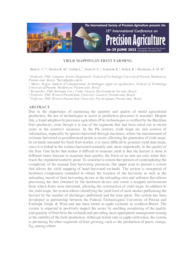Yield mapping in fruit farming.
Yield mapping in fruit farming.
Author(s): BAZZI, L. C.; MARTINS, R. M.; GEBLER, L.; SOUZA, G. E.; SCHENATTO, K.; SOBJAK, R.; HACHISUCA, A. M. M.
Summary: Due to the importance of increasing the quantity and quality of world agricultural production, the use of technologies to assist in production processes is essential. Despite this, a timid adoption by precision agriculture (PA) technologies is verified by the Brazilian fruit producers, even though it is one of the segments that had been stood out in recent years in the country's economy. In the PA context, yield maps are rich sources of information, especially by species harvested through machines, where the measurement of volumes harvested at georeferenced points is easier, allowing the generation of yield maps. In orchards intended for fresh fruit market, it is more difficult to generate yield data/maps, since it is linked to the volume harvested manually and, more importantly, to the quality of the fruit. One factor that makes it difficult to measure yield is that the harvest is done at different times because to maintain their quality, the fruits of an area are only when they reach the stipulated maturity point. To construct a system that permits of contemplating the complexity of the manual fruit harvesting processes, this paper aims to present a system that allows the yield mapping of hand-harvested orchards. The system is comprised of hardware components (intended to obtain the location of the harvester as well as the unloading record of their harvesting device at the unloading site) and software that allows processing the data obtained by the hardware device and create a mapped environment from which fruits were harvested, allowing the construction of yield maps. In addition to the yield maps, the system allows identifying the yield level of each worker performing the harvest by the number of discharges performed and the time spent. The system has been developed in partnership between the Federal Technological University of Paraná and Embrapa Grape & Wine and has been tested in apple orchards in southern Brazil. The system is expected to positively impact the sector by enabling monitoring of the quality and quantity of fruit from the orchards and providing more appropriate management aiming at the stability of the field production. Although tested only in apple cultivation, the system is promising for other segments of fruit growing, such as the production of pears, orange, fig, among others.
Publication year: 2022
Types of publication: Paper in annals and proceedings
Unit: Embrapa Grape & Wine
Keywords: Orchards, World agricultural production, Yield maps
Observation
Some of Embrapa's publications are published as ePub files. To read them, use or download one of the following free software options to your computer or mobile device. Android: Google Play Books; IOS: iBooks; Windows and Linux: Calibre.
Access other publications
Access the Agricultural Research Database (BDPA) to consult Embrapa's full library collection and records.
Visit Embrapa Bookstore to purchase books and other publications sold by Embrapa.

